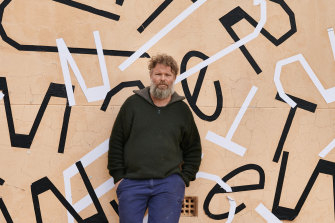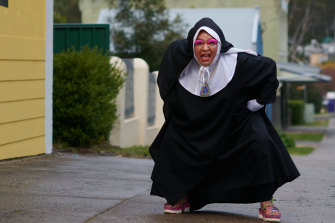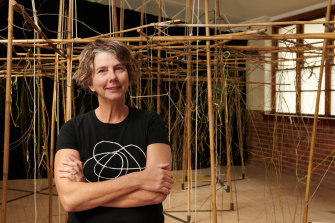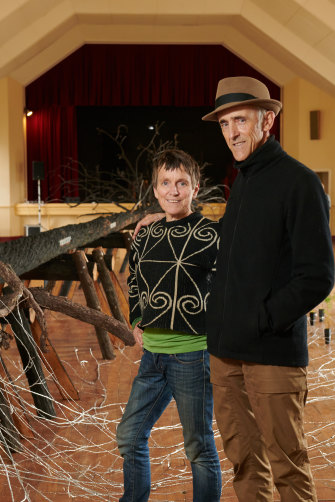By Nick Galvin
Kandos, about an hour north-west of Lithgow, is a pretty quiet town – doubly so since its main employer, the cement works and quarry, closed its doors in 2011. The second hammer blow came in 2015 when the nearby Chambon coal mine also shuttered.
But this particular morning there is barely a parking spot to be had on the 25m wide main street. There are other signs something is afoot. I meet performance artist Juundaal Strang-Yettica, aka Sister GlitterNullius, wandering along the pavement in full nun’s habit complimented by extravagant blue eyelashes, tolling a school bell and dragging behind her a doll’s house.
‘People in Kandos are really upfront with you’: Festival director Alex Wisser. Credit:Gus Armstrong
She explains that she belongs to the Sisters of Perpetual Plastix and because her DNA has been infected by microplastics she is in the process of morphing into a bird. Presumably, this is not an average Saturday morning conversation in Kandos.
Meanwhile, a group of about 40 people are pacing silently around an empty paddock. It’s a walking meditation that aims to help them become “mindfully present with the vibrant sentience of the surroundings”. Again, presumably not an everyday occurrence here.
This is the fourth iteration of Cementa, a bold, four-day, biennial contemporary arts festival that bills itself as “a unique, regionally situated, socially-engaged, artist-led organisation dedicated to cultivating contemporary art in our regional context”.
Self-described “artshole” Alex Wisser is the man behind all this.
“I make, write about, think, organise, eat, breath, love, hate, talk and sneeze art,” he says on his website. “If you ask me why, I will tell you it is because I failed as a poet but when I say that, I am just being cute.”
Sister act: Juundal Strang-Yettica wanders the streets of Kandos in costume.Credit:Gus Armstrong
In person, he is a hugely engaging, stocky, heavily bearded Californian transplant, exuding an almost manic passion for Cementa and the Kandos region.
He and his family settled in Kandos in 2012, moving from Sydney’s inner-west where he had been active in the contemporary art scene.
Cementa grew from a conversation Wisser had with Ann Finnegan a co-founder of the festival. They figured the disused cement works would be a great place to activate with contemporary art. That suggestion was met with a flat “no” from Cement Australia on safety grounds.
“But a number of the town leaders came to the table,” says Wisser. “And they were all very encouraging. They saw the town was going to need something to revive its future – there was a lot of anxiety around the fact it was losing its defining industry. And while art was certainly not their idea of what would do that the very fact we showed up at that moment and they could see we would be bringing economic activity into the town made it an attractive option.”
Leanne Thompson with her woven installation, Permeare, at St Dominic’s Church Hall in Kandos.Credit:Gus Armstrong
Inevitably, responses from long-time Kandos residents to the prospect of a cutting-edge contemporary art festival coming to town, with all the exuberance, zaniness and way-out ideas that implies, were mixed. Reactions ranged from bemusement to plain hostility.
“One of the great examples,” says Wisser, “was when we were thinking about doing an installation in the swimming pool and we called council to ask if we could do that and I had a council worker call me back and ask, ‘So you want to put paintings in our swimming pool? Do I understand you right?’”
After the first event, Wisser and his team did a community consultation, asking for feedback and suggestions.
“One woman sort of sat in the corner of the meeting with her arms crossed for most of it,” he says. “Then, she said, ‘You’ve got to understand how scary this was for a small town like Kandos. We basically thought you were coming up here to look down your noses at us and laugh and make fun of us’.”
It brought home to Wisser how class-laden contemporary art can be.
“Contemporary art is identified as a middle-class cultural expression and is alien and threatening to a lot of people who don’t participate in that culture or have access to it,” he says.
But it speaks volumes for Wisser’s passion, perseverance – and diplomatic skills – that the four-day festival has gone through four iterations now, becoming bigger and more inclusive each time.
Artists Alison Clouston and Boyd with their installation Dhalawala – Forest Country at the Kandos Community Centre Hall.Credit:Gus Armstrong
There are installations or performances in almost every part of the town, from the disused railway station to the scout hall and the main street shops to the golf club.
The local RSL is transformed for one night to present a “Vaudevillian rollercoaster ride of community-style slam, glam punk entertainment”, while the community hall plays host for the weekend to a stunning installation featuring a massive burned tree attached to 50 of its living seedlings and accompanied by a specially composed choral work.
And Cementa is now much more than a biennial festival – it has a presence year-round with residencies and other local projects, including artist Leanne Thompson’s innovative project, Weaving Water, which aims to bring people together to restore the waterways across the Capertee Valley.
Recently, organisers also raised $180,000 to buy the old town hall building on the main street to establish a permanent art space.
Indigenous work and performance is woven through much of the festival, driven by Uncle Peter Swain, a local Dabee Wiradjuri Elder.
“I was involved with the last festival,” he says. “And, yeah, there were conversations around ‘that’s not our thing, just let them do their thing’. The locals would go and hide inside for three days and then come out again on Monday. But that’s breaking down this year, I’ve noticed.”
Swain has little time for locals looking down their nose at artists who have flocked to the region, some of them buying homes there.
“What is it to be local?” he says. “For me, if somebody lives here and they really love this place and they love it for what it is then I consider them a local whether they were born here or not. I bridge all those dynamics because of my background. When someone goes, ‘I’m fifth generation’. I can say I’m about 3,000. Don’t pull the local card on me.”
Twenty-three-year-old Bridget Baskerville grew up in the region and the impact of the industrial closures are still fresh in her mind.
“Lots of people I went to school with had to leave with the families,” she says. “It felt quite quick. And then there are less and less businesses. That seemed gradual and then you get to the point where you look around and realise we’ve lost a lot of the things I grew up with.”
Baskerville is volunteering at this year’s festival and has detected a shift in the response from her community.
“It’s a dwindling town, which can be quite sad, so suddenly to see people again reminds people of how it used to be. I think that’s really exciting. I’ve even had conversations in the past few days with people saying, ‘This isn’t really my thing but actually I’m quite interested in what’s happening’.”
Wisser doesn’t shy away from the challenges of staging a contemporary arts festival in a region struggling to come to terms with its post-industrial future. On the contrary he sees those challenges and that sometimes uneasy relationship as central to the project.
“We’re talking about a dialogue between two cultures. It’s always a process. It’s never solved. I don’t want anybody to think that I’m crowing about this as though it’s something that’s succeeded.
“We’ve had our small successes, which I’m very happy with, but those small successes along with all of our failures and breakdowns are what teaches us. It’s how we learn what the nature of our society is.”
He lives for the occasions where barriers do come down and recalls a moment at the first festival where local women and artists shared stories in a spinning circle.
“I felt like these two worlds were able to fit together for a moment of shared meaning. And just the fact that it was possible for that moment really informs a lot of the hope I have, or that I derive from what we do here.”
For the artists, there is also the chance to experience the sort of refreshing candour that they don’t often get in the city arts bubble.
“People in Kandos are really upfront with you,” Wisser says. “They’ll let you know if they think something is silly, absurd or a crock of shit. It’s not a foregone conclusion that everyone’s going to congratulate you. You might get someone walk up and say, ‘Well, you’re wasting your life, aren’t you?’.”
But for all his optimism, Wisser remains firmly grounded about what can be achieved.
“The lesson we learned at the first festival, is that art is not a silver bullet. Art will never save a town. It’s not an industry like a coal mine. It does bring financial benefit with it, but it really works within a mix and context. And while it’s very romantic and maybe endearing to people in the city, proposing to people in this town that you’re going to ride in on a white horse and save the day with art is ridiculous and a bit patronising.”
A cultural guide to going out and loving your city. Sign up to our Culture Fix newsletter here.
Most Viewed in Culture
Source: Read Full Article



